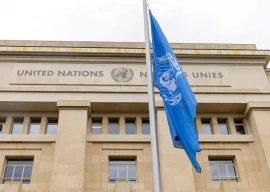
UN High Commissioner for Human Rights Navi Pillay said in Geneva that 59,648 people had died through the end of November in the 21-month conflict, which began as a peaceful uprising in March 2011.
"Given there has been no let-up in the conflict since the end of November, we can assume that more than 60,000 people have been killed by the beginning of 2013," Pillay said in a statement.
"The number of casualties is much higher than we expected, and is truly shocking," she added.
Pillay said in December 2011 that the UN was unable to provide precise figures on the number of deaths, and media have since been relying on the Syrian Observatory for Human Rights, which put the total on Monday at more than 46,000.
"Although this is the most detailed and wide-ranging analysis of casualty figures so far, this is by no means a definitive figure," Pillay said.
Analysis has shown a steady increase in the average number of documented deaths per month since the beginning of the conflict, growing from around 1,000 in the summer of 2011 to an average of more than 5,000 since July 2012.
The casualties continued to pile up on Wednesday, when a regime air strike in the Eastern Ghuta region of Damascus killed or wounded dozens of people, many of them horribly burned, the Observatory said.
"There are 12 bodies that have been found at the scene, but it is not yet clear whether they were civilians or rebels or if the gas station was the target," Observatory director Rami Abdel Rahman told AFP by phone.
The Local Coordination Committees, a grassroots network of activists, estimated that at least 50 people were killed and dozens of others wounded.
It said the toll was likely to rise because bodies were still being pulled from the rubble, adding that "it is extremely difficult to count the dead because most of the bodies have been immolated."
A gruesome video posted on YouTube purported to show the aftermath of the attack, with many of the bodies burned.
It was not immediately clear if the bomb blasts caused the storage tanks to explode, but the scene was engulfed in fire, which suggests that was the case.
"MIG warplane strikes on Eastern Ghuta! Dozens of martyrs!" a man in the video shouted out as he and a fellow cameraman raced toward plumes of smoke to survey the damage.
One man stood wailing to God as he held what was left of his friend, a head and a shredded torso with a bloodied shirt still hanging on flaps of skin.
Another man was still atop a motorcycle in the middle of the fire, his body engulfed in flames.
Elsewhere, the Britain-based Observatory said regime warplanes bombed the town of Moadamiyet al-Sham, southwest of the capital, killing 12 members of the same family, most of them children.
The strikes came as President Bashar al-Assad's forces shelled rebels in insurgent strongholds to the northeast of the capital, and in Daraya to the southwest.
South of the capital, residents of a Palestinian refugee camp that faced air raids in December were sent fleeing once again by barrages of mortar fire.
In northwestern Syria, clashes between mostly jihadist rebel fighters and Assad's forces at Taftanaz airbase in Idlib province killed four insurgents and an unknown number of soldiers, the Observatory said.
Fighting also broke out around the crucial Wadi Deif base, one of the last regime bastions in the northwest, in a fresh jihadist-led bid to wrest control of the strategic post.
An Australian national fighting alongside rebels was among those killed, the Observatory said.
Australian "Abu al-Walid al-Australi was killed... in a rebel assault on Wadi Deif," Observatory director Rami Abdel Rahman told AFP via telephone.
The Al-Nusra Front has led the offensive against Wadi Deif, according to rebels on the ground.

1722586547-0/Untitled-design-(73)1722586547-0-165x106.webp)


1732326457-0/prime-(1)1732326457-0-165x106.webp)


1731325890-0/trump-(24)1731325890-0-270x192.webp)









COMMENTS
Comments are moderated and generally will be posted if they are on-topic and not abusive.
For more information, please see our Comments FAQ